The Northrop F-5 Enthusiast Page - Home
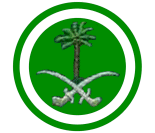
- لقوات
الجوية الملكية
السعودية
- Al
Quwwat al Jawwiya al Malakhiah as Sa'udiya
- Royal
Saudi Air Force
Saudi Arabian Roundel - Credit Roundels of the world
Unit
Last update 31-01-2023
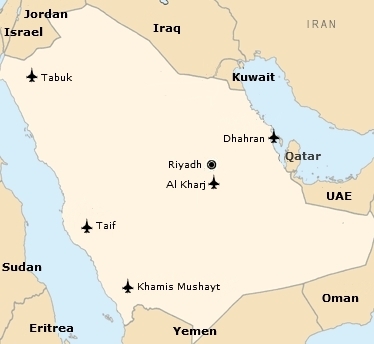
All Saudi Arabian bases were renamed in 1999 after members
of the Saudi Royal Family (earlier they were named after the city where
they were based plus Air Forces Base) and Wings were introduced.
Dhahran AB was renamed King Abdul
Aziz AB - 11 Wing, Tabuk AB King Faisal AB - Wing 7
Khamis Mushait AB King Khalid AB - Wing 5 , Taif AB King Fahad AB - Wing 2
Air Force Northrop F-5 related bases
PROCUREMENT
In January 1964 there were cosultations between the US and the Saudi
governments regarding the possible purchase of a new fighter to
arm two/three Squadrons. The US
preferred to
offer the Northrop F-5A Freedom Fighter over the Lockheed
F-104G or F-104H to limit the use of the aircrafts in short range,
air-defence and light ground-attack duties. Northrop F-5B
demonstrator
serial 63-08442 was evaluated in June 1964 at Wiesbaden, in August 1964
at Dhahran (serial 63-9845).
Contemporanously British Aircraft
Corporation conducted demonstration flights in Riyadh
of the much more powerful, but highly complex, Lightning F.3 and on 22 December 1965 Saudi
Arabia announced an order to
supply for 34 BAC Lightning F. 53 and 6 Lightning T.55, putting an end to US
hopes.
A
new, ambitious, programm to develop the Air Force was established in
the early 70', when a less sophisticated aircraft, mainly for ground
attack and as secondary role, was looked
for to train local personnell
and reduce the heavy dependence on foreign military support and of
contractor technicians.
Saudi aim was to achieve self-sufficency in all facets of
Northrop F-5
operations (training and support), but to leave room for augmentation by
outside help.
In USA Northrop Corporation was given
permission by the Department of State to demonstrate the weapon system
capability of the Northrop F-5 to the Saudi government. This
demons-
tration was closely monitored by the local United States Training
ission (USMTM) based at Dhahran AFB. This was responsible for assisting
the Saudis in determining military requi-
rements and for providing
unbiased information on USA that could
satisfy the
requirements. Saudi Arabia wished an package where only one contractor
was responsible for technical development and control of production
plus one responsible for
production and maintenace.
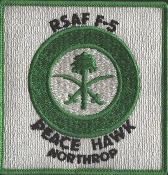
The
Northrop F-5, modified in an pecular to the country form, was selected;
purchase went through US Foreign Military Sales channels. Technical
support was
integrated into the US Air Force spares system so that
parts and even complete refurbished aircrafts would be obtained from
USA. A large, double then required
by NATO, stock of spare parts was
bought and stored at airbases and dispersal fields. All this was
included in
the Peace Hawk programm, while 4 Lockheed
KC-130H based at Jeddah provided air-to-air refuelling.
SAUDI/USA PEACE HAWK PROGRAMM I to VI
Introduction
of the Northrop F-5 was accomplished in six phases, each named like the
programm, followed by a Roman number. It lasted from 1971 till 1986.
Air-to-air missiles were
also bought in the form of 1000 AIM-9J and,
later, 600 AIM-9P-3 Sidewinders. Lockheed KC-130H, air-to-air refuelling aircrafts, were received in 1975 to enable rapid deployment to
the very distant bases, initially four (later four additional ones).
Three USAF commands (and Tactical Air Training Command) were heavily involved in the six programm phases.
Military Airlift Command provided airlift of materials and aircrafts; Air Training Command provided Mobile Training Teams and Mobile Training Detachments; Tactical Air Command
was responsible for all Saudi pilots/instructor pilots training and USAF pilots flight tests at Edwards AFB.
Corruption allegations involved all armament/aircraft sales to Saudi Arabia.
- Peace Hawk I
- A Letter of Offer and
Acceptance for 20 Northrop F-5B two-seat trainers was signed on
23-07-71 for USD 42.3m by the Saudi Arabian Minister of
Defense and Aviation, and included
- USD 25.2m for the
aircrafts, the remainder for bases construction, check-out equipment, spares, mobile
training units and various other support equipment. Contractor technical
- support was planned for a five-year
period at a cost of 1.2 million USD.
- At first, three Northrop
and one
General Electric product service engineers were provided, with
reassesment of the requirements for their service to be accomplished
after two years.
In-flight delivery (via the Atlantic in USAF markings) of the first two
Northrop F-5B was on 07-09-72, followed by two on
10-10-72, completed on 05-02-73 when the last six were
delivered.
They replaced in the Operational Conversion Unit at Dhahran AFB having Lockheed T-33As (No 15 Squadron) and North American F-86Fs (No 7 Squadron), both available to
graduated pilots at the King Faisal Air Academy. The introduction of the new trainer was fulfilled without problems.
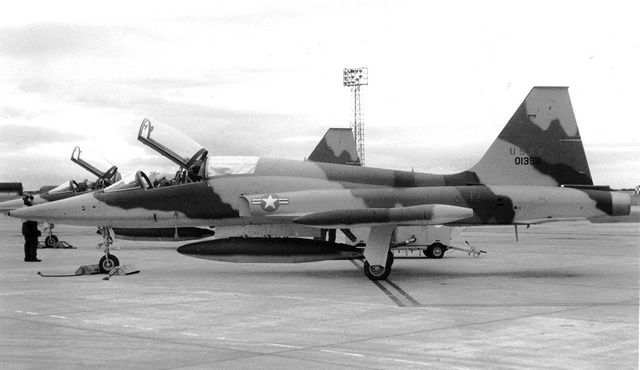 Photo:
The Northrop F-5 Enthusiast collection.
Photo:
The Northrop F-5 Enthusiast collection.
Northrop F-5B 01352 in USAF delivery markings
departing Prestwick on 05-02-73 under an winter sky.
Peace Hawk II
Peace Hawk II phase started on 29-09-71
with the signature of a Letter of Offer comprising 30 Northrop F-5E at
the value of USD 106.7 millions, of which USD 56.8 for the aircrafts
and
the remaining amount for the purchase of support equipment: spares,
contractorial technical support and aircraft delivery by Locheed C-5.
Three Northrop product engineers were also fore-
seen and one from
General Ellectric for only a period of two years (five in Peace Hawk I).
Problems
occurred due to three
configuration changes requested by Saudi Arabia after
production had already started. First request was in June 1972, it
involved the installation of an
Inertial Navigation System (INS), The
second one was asked in October 1972: in-flight refuelling capabilit;
and third in February 1973 the installation of a sophisticated
Instruments
Landing System (not foreseen for other
countries). It included the change of INS, an
in-flight refuelling system, reconnaissance nose with a KS-121A camera, and
an updated Instruments
Landing System. All these changed brought the
total cost to USD 129.4 millions, particularly as the USAF needed to
flight-test the new features; they resulted in first aircraft delivery
slipping from December 1973 to January 1974, but was completed in late
1974 according to plans.
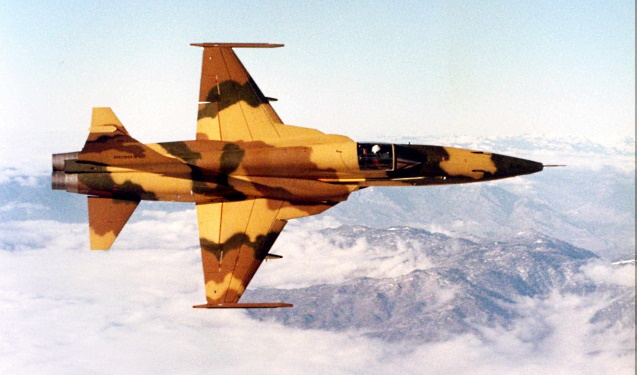 Photo: Northrop
Photo: Northrop
Overfuselage view of first Tiger for Saudi Arabia, with reconnaissance nose
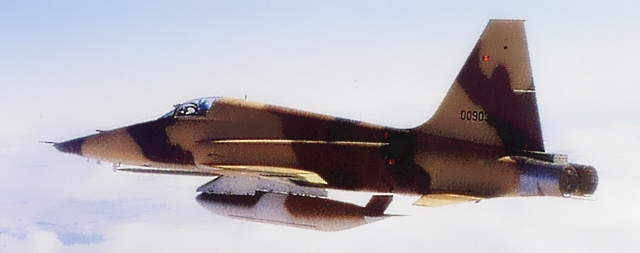
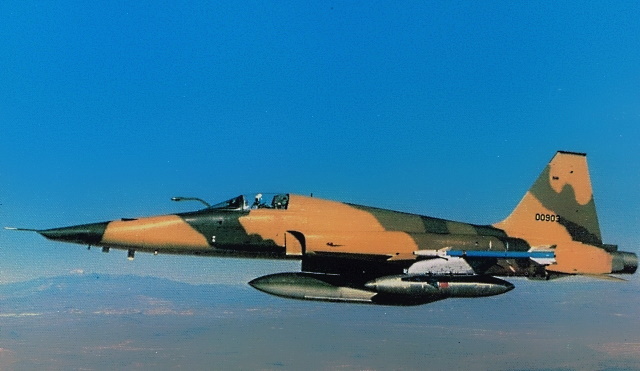
First Northrop F-5E built for Saudi Arabia, 00903,
in early tests with Northrop RF-5A Same aircraft armed with Sidewinder and an air-to-air refuelling
drogue
nose without
an air-to-air refuelling
drogue
A fake serial?
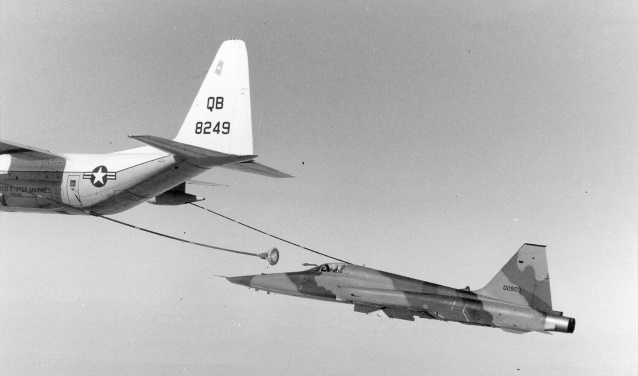 All photos: Northrop
All photos: Northrop
Same aircraft on refuelling trials from US Navy C-130 8249
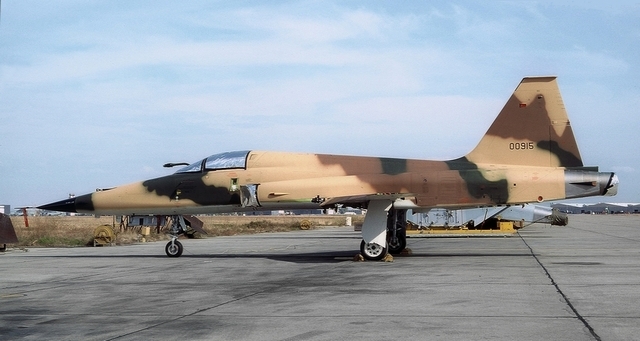
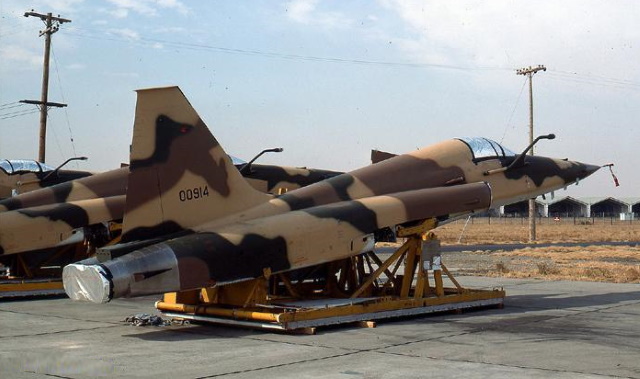
Northrop
F-5E 00915 (Peace Hawk II) awaiting delivery ar McClellan AFB in
1974
Northrop F-5E 00914 on pallet, ready to be transferred by air to S Arabia
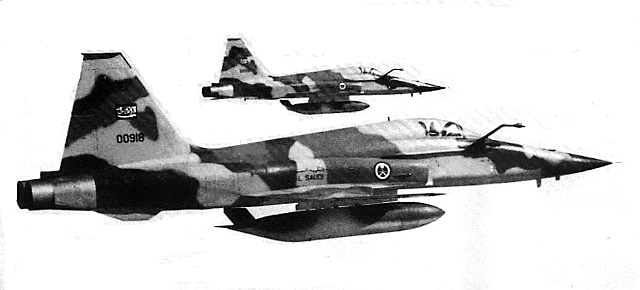 Photo: Northrop
Photo: Northrop
Northrop
F-5E 00914 with USA serial, Saudi nationality markings
Delivery by Lockheed C-5 of the second phase fighters was foreseen to start in December 1973 but
was actually in February 1974, due to the late modification
changes request.
It was completed on schedule in late 1974.
A fly-pass in honour of King Faysal on 03 December 1974 showed 16 Northrop F-5.
Peace Hawk III
On
reqest from Saudi Arabia an USAF survey team was sent to the country
during September and October 1974; this team performed a survey of
Dhahran and Taif AFB, realising the
need for augmented training support.
This was answered by a Saudi request that the USA was
to provide maintenance, training and support; Northrop Corporation was
to be the sole contractor. Goals were set regarding
tentative aircraft
utinization (20 hours per aircraft per month) and aircraft rates was to
be 71% Operationally Ready, 5% not Oprationally - Ready Supply, 21%
Not Operationally -
in Maintenace.
On
09-02-72 a contract was signed; it was originally to end
on 15-08-76 but was extended to 15-12-76 with the signature of an agreement on 29-07-75, total value USD 265.7.
No aircrafts were foreseen, primary objective remained to assist the RSAF in
achieving maximum self-sufficiency in the operation and support of
their aircrafts. Northrop
was to train
pilots and technical training for assigned RSAF personnel,
construct and modify required facilities at Dhahran and Taif Air Bases,
conduct English language courses, required main-
tenance and supply
support while training RSAF personnel to assume these duties. An F-5
Pilot Training Team (by Northrop Training Team assisted using a
programm developed by
the USAF/Air Training Command), pilots received
training in USA, Williams AB, in order to qualify to instruct
in the
Peace Hawk progrmm). Two Contractor Technical Training teams (Northrop)
were also sent for all Northrop F-5B and F-5E for maintenance training
necessities.
Peace Hawk IV
The
fourth phase negitations started in October 1973 with a price request
for 50 Northrop F-5E; in summer 1974 it was modified to read 40
Northrop F-5E and 20 Northrop F-5F.
Purchase negotiation were only completed and signed on 04-01-75 due to the oil embargo by the
Arab states;
delivery was foreseen between 1977 and 1980 for the cost of circa
USD
796 millions.
These
aircrafts were to be fitted with more sophisticated systems,
including APQ-159 improved radar, four underwing launchers for
the, 1'000 purchased in 1976 AGM-65A Maverick/
laser guided bomb
capability (also seen as an anti-ship weapon), APX-101
IFF, ARN-108 ILS/CPO-80 (MOD) Flight Director Computer,
ALR-46(V)-2 Radar Warning Receiver, ALE-40
Chaff/Flares,
Northrop AVQ-27 manual laser target designator, provision for the
ALQ-101/119 ECM pod, Jest Assisted Take-Off (JATO) provision,
developments of some was financed
by
Saudi Arabia. Two simulators were also included in the programm as well
as ten interchangeable reconnaissance nose kits for the
single-seaters. Discussion were also held for
the installation of
improvements: Laser Guded Bombs, Maverick air-to-ground missiles and an
improved radar but they were not finalized.
The contract included two Northrop F-5E built by Singer-Link.
Peace Hawk IV icluded
retrofit of earlier aircrafts: remaining 29 Northrop F-5Es 12 had
been lost earlier). These were to be upgraded to
the same systems as the new production ones;
18 Northrop F-5B (2 had been lost earlier) were
also upgraded with new radios and TACAN. The retrofit choice was
between partial in Saudi Arabia or full either
in Saudi Arabia or by
Northrop at Palmdale being transferred by
Lockheed C-5 to/from USA.
This last option was chosen, modification
began in July 1977 and was completed by December 1978. Flight testing
with an USAF Northop F-5E was scheduled in June 1976 but was
postponed
in order to be able to modify the USAF aircraft with all new options.
Production delivery started in September 1976, two single-seater
aircrafts had been completed by this
month, used for production verification the same
month together wih two Northrop F-5F (respectaby delivered in
December 1976 and January 1977). Testing was scheduled to last till
December 1977 while retrofit of all Peace Havk Saudi aircrafts was
scheduled to begin in July 1977 and be completed in July 1978.
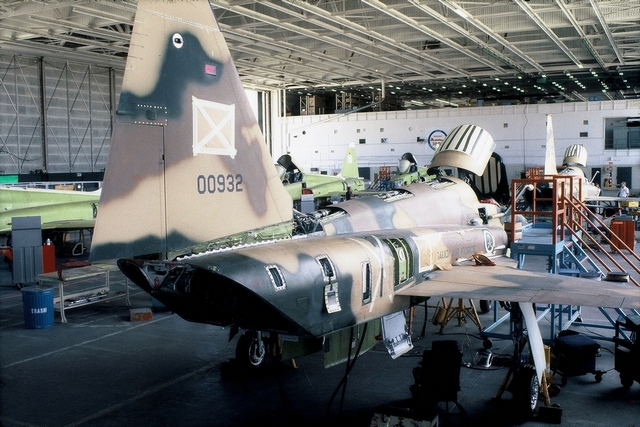 Photo: Franz Wegmann
Photo: Franz Wegmann
Last aircraft of the second phase programm
being reworked on the line at the Palmdale plant - June 20th, 1978
- Peace
Hawk V
- A
long-lead contract study by the USAF was started in February 1975 in
order to have further general improvements. This programm was finalized on 31-01-76 and signed on 22-02-76,
- valued at USD 1'574
millions;itwas a
government-to-government contract not-to-exceed USD 1,58 millions
for a period extended from 14-02-76 till 15-02-79. It related to
maintenance
- services needed to support the general Northrop F-5systems,daily
flying and training schedules. Aircraft utilisation rate was given pro
aircraft 20 hours per month, a rate of 71 percent
- operationally ready,
not operable due to maintenance of no-more than 24 percent.
- Accent was again placed on the global goal to train for self-sufficency on all
Northrop F-5 bases: Dhahran, Taif, Khamis Mushait.
The study ended in
October 1975 and was submitted to the Saudis, which approved it on
28-10-75. It included an newa-a radar APQ159 and automatic test equipment.- Contract was signed on 22-02-76, covering the upgrading of the Saudi Air Bases system and
including operating depot supply activity at Dhahran, building of
three new bases during a
- period between 13-02-76 till15
June 1979. These bases (amog which Khamis Mushait) were built to support the F-5s,
but, equipped with the latest test equipment, the facilities would
- support also McDonnel F-15 at a later stage. By February 1977
half of the foreseen technical faciliities were in a progress status,
the others were to be started in 1978. Principal
- difficulties
were: obtaining visas for third countries national power people, building
permits andsecurity passes, while training programs were also behind
schedule due to human
- resourcesproblems.
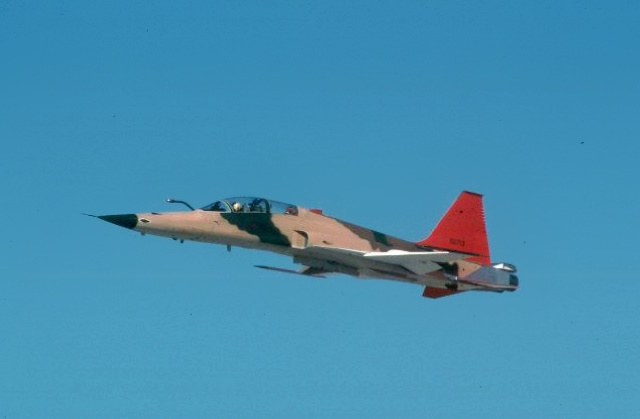 Photo: Collection F-5 Enthusiast
Photo: Collection F-5 Enthusiast- Peace
Hawk VI
Negotiation for the last phase of the programm started in March 1976 with the request of four Northrop F-5Fs,
probably to replace lost ones. The contract was only signed on 30 January
1977 as the cost of approximately USD 23,3
millions. Aircrafts were more expensive than those of earlier phases, but they were similar to those of Peace Hawk IV. Foreseen delivery by
Lockheed C-5A was in the second quarter
of 1978. The last 2 two-seaters were seen at McClellan AFB in April 1978 on the delivery phase. Sale of 5 Northrop F-5E as widely mentioned,
known US serials are only for 30 Peace Hawk II phase aircrafts.
By 1986 there were 22
Northrop F-5E/F-5F at Khamis Mushayt AB, 36 Northrop F-5E/F-5F and 8
Northrop RF-5E at Taif AB. The purchase of a total of 2500 AGM-65A and AGM-65B missile
gave them an attack capability.
THE END OF PEACE HAWK PROGRAMS CAME IN 1986, WHEN THE PROGRAMM WAS PHASED OUT
The acquisition
in March 1982 of 10 Northrop RF-5E, supplementing the camera nose equipped
Northrop F-5E, was needed for a dedicated
reconnaissance capability. It was not part of the
Peace Hawk programm.
The first three Northrop RF-5E transited Prestwick airport
(United Kingdom) on delivery on 13-01-85, the last on 22-03-85. At
least four, unusually, wore a very dark black colour, the
others a normal desert camouflage.
Taif AB housed iin 1986 eight Northrop RF-5E reconnaissance aircrafts.
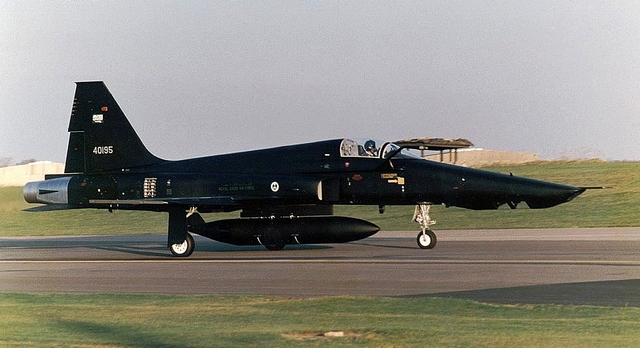
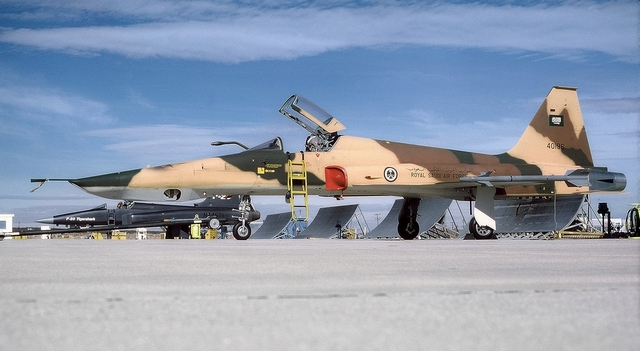
Northrop
RF-5E 40195
painted in black transiting Alconbury AFB on
delivery.
Northrop
RF-5E 40196 in desert camouflage at Edwards AFB in 1985. In the- Photo:
unknown
background the third prototype of the ill-fated Northrop F-20
-
Photo: The Northrop
F-5 Enthusiast collection
- Sevice enter/use
The first class of F-5 pilots was graduated in summer 1973, when 16 Saudi-piloted Northrop F-5B participated to a flypast at Dhahran AB. Another flypast, by 16 Northrop F-5s of the
Operational Conversion Unit, took place in front of King Faisal on 03-12-74 at Dhahran AFB , together with 16 E.E. Lightnings.
Preliminary operational status was reached by the first two combat Squadrons by late 1975.
By 1977 there were 35 Tigers based at Dhahran (some
mention 20) together with 20 Lightnings, 24 AB.205 helicopters for
Search And Rescue plus 35 Northrop F-5s based at Khamis
Mushait AB.
Northrop
F-5E replaced the BAC Lightning F. 53 in the attack and
reconnaisance role, and, by 1978, they were RSAF's
chief multirole fighter,
including
for the protection of sea lanes.
BAC Lightnings
were formally retired from Saudi service at the end of 1985; there were in 1986 22
Northrop F-5E/F-5F at Khamis Mushayt AB, 36 Northrop F-5E/F-5F and 8
Northrop
RF-5E at Taif AB.
The
purchase of a total of 2500 AGM-65A and AGM-65B missile gave an attack
capability to these aircrafts. A Taif AB an USAF detachment assisted
the local Saudi McDonnell F-15,
Northrop F-5E/F and RF-5E units.
Air-to-air refuelling was extensively trained with Lockheed KC-130H as tankers.
By
1986 new pilots were trained in the USA after completing 12 hours
and 42 weeks respectively on the Cessna 172 and BAC-167
Strikemaster at
the Air Force Academy. Only circa 50
pilots advanced to flights on the
Tiger and unsufficent technical personnel. Only Tiger units could
function without enlisting foreign specialists. At Dhahran AB 2
McDonnel F-15 and
2 Northrop F-5E stood on a five minutes alert around
the clock.
Saudi
Arabia did not participated wit its armed forces to the First Gulf War
(1990) as it claimed to be neutral, though a considerable part of US
forces was stationed on its territory.
Northrop F-5Es flew close support and aerial interdictions against
Iraqi units in Kuwait; one aircraft was lost on ground fire on
13-02-91, its pilot killed.
Operation since mid 1990s
In mid-1990s, the Kingdom began entering into agreements directly with
the third-party service providers to obtain maintenance and support
for the F-5 fleet. This was earlier done
through Peace Hawk organisations,
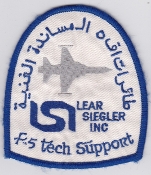
On
10-03-94 an agreement was signed with Lear Siegler to provide
technically qualified contractor manning to augment, assist, train
and advise RSAF personnel
in overhaul/repair of aircrafts, ground
equipment and navigation aids for F-5 operation; on 16-03-95 as well as for support
services, on 10-10-95 for spares; on
15-04-96 again for support
services; on 20-06-97 for technical data and assistance.
Under these contracts, F-5 parts and components needing repair
were shipped from Saudi Arabia to Lear in San Antonio. Additonally Lear
sent personnel to Saudi
Arabia. These integrated with RSAF personnel providing training and support in post-ejection
survival, photo reconnaissance, flight operations and in fighter
weapons and tactics.
From 1994, poor leadership of the Air Force, the mishandling of
overall training, underfunding and mismanaged Saudition, brought the
Air Force to the point of
near-crisis. Lack of readiness, poor aircrew and maintenance to
aircraft ratios (heavily depending on foreign labour and knowledge)
forced the near-grounding
of the Northrop F-5s. The total
in-country operation and maintenance was secured by a local company,
All Mozoon Group (in partnership with Lear Siegler), with the
acquisition of all
new and rebuilt parts.
Remaining nine Northrop RF-5E were upgraded with
the installation of Global Positioning System navigation in a
$7.4m deal with Northrop Grumman in 1997. Twenty-seven Northrop
RF-5E
mission-planning systems were purchased from Lockheed-Sanders
Corporation (now BAE Systems) in 1995; structure was strengthened to
prolongue operational life.
According to USA information 98 aircrafts were available in 1995.
-
The earlier
mentioned contracts with Lear-Siegler expired
in 1999; aircrafts parts still in storage at San Antonio and Saudi
Arabian taxes claims leaded to an US court dispute only
- partially
solved ther claims 10 years later.
An
USA 2003 study mentioned that the Air Force had reached something of a
readiness crises; operational capability had dropped badly between 1992
and 2001; Saudi Arabian
- Northrop F-5E had lost virtually their operational capability.
- The Second Gulf War (beginning 19-03-03 and lasting over one month) saw
the participation of the Saudi Air Force with 53 Northrop F-5E/F-5F
(106 sorties) and Northrop RF-5E
- (20 sorties), all based at Tabuk, thoughthe reconnaissance fighter did not fare well as they were
largely useless in seeking out targets and rapidly processing
information.
It is not confirmed that approximately a dozen Tigers were reactivated only for a short time in 2010 during the initial stage of the war against Yemeni Houti rebels,
Replacement/retirement
Requests for authorisation for purchase of spares for Northrop F-5 and
RF-5 were placed with the US Governement till at least October 2005,
but number of Squadrons operating
Tigers were constantly reduced (see Units/operation page).
- The
lightweight, short range Northrop F-5 played a major role in the
establishment of the new Royal Saudi AF. Stratergy was modified in the
mid-eighties: it was changed from a
- light/point defence fighter/attack aircraft to a heavy one to defend the vast extension of the
country and (mst important) its oil-fields. Financing was
helped by income from crude
- oil sales.
- It found the aircrafts in the form of 46 McDonnell F-15C, 16 F-15Ds for the
first role and BAE Tornado IDS for
the seconde role. Only one Tiger unit was re-equipped with some
- Tornados IDS (No 7 Squadron) foroperational conversion training; others
were disbanded to make place to heavy duty fighters when received - McDonnel F-15 between January 1982
- and May 1983, BAE Tornado between 1996 and 1998.
- Lack
of finance (due to the oil crise) and
necessity to improve
readiness, training, and capability for joint operations were
factors that delayed the selection/purchase of a less heavy
- aircraft
till 2007 when (onSeptember 11th) a contract was signed with the
United Kingdom government for the acquisition of 72 Eurofighter
Typhoons. First 2 reached Taif AB on
- 24-06-09. The initial examples
were delivered to the earlierdisbanded, earlier Northrop F-5 equipped
units, No 10 and No 3 Squadrons.
- Preservation and sales efforts
- The only known preserved aircraft is at the Air Force Museum Northrop F-5F, on show at his premises in Riyadh, first noted in April 2006. It is rumoured as a former Jordanian aircraft.
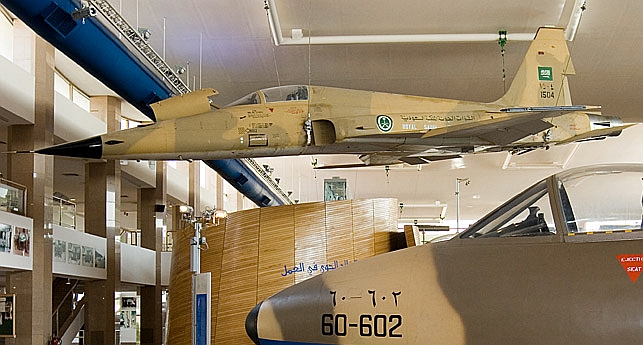 Photo: flyart
Photo: flyart-
Northrop F-5E 1504 at the Air
Force Museum in Riyadh on 15-11-07
According to unofficial sources an
offer for sale of 55 Northrop F-5E/F was issued on 17-08-09, additional to
follow later; two simulators for each 15 aircrafts purchased were
available
as well as a free training programm for 4 aircrews and 4
groundcrews per 15 aircrafts purchased. No price was given, just the
highest bid; no aircraft could be sold.
Another tentative to sell 79 Tigers was started via an US broker
(AvBuyer) on
18-12-14, opening date of envelopes offers being the 20th February
2015 without success; a satellite
image shows 78 Northrop F-5E, F-5F
and RF-5E stored at Taif - Al Fahd AB along an auxiliary runway.
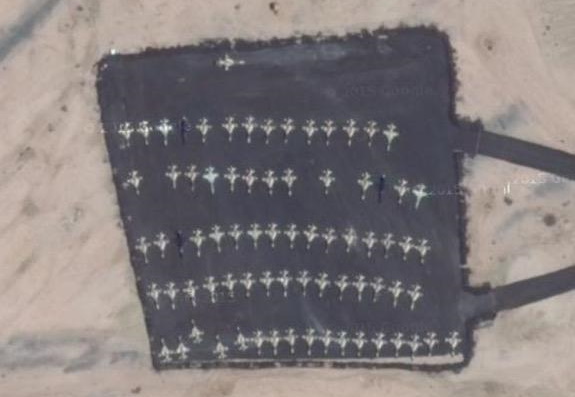
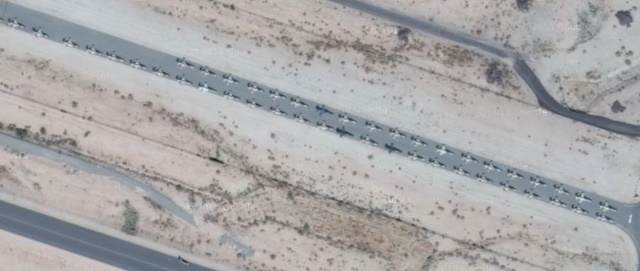
Northrop
F-5E/ F-5F (45) and RF-5E (3 black) later on a lateral runway at Taif AB probably 2015; where are the others? Stored on an enormus tarmac at Taif AB 73 Northrop F-5E/RF-5E
and 3 black Northrop RF-5E Fortyeight of the strored Northrop F-5 have been offered to Tunisia in
the context of security co-operation between the two countries, but not accepted.
-
Losses
No
exact information is available regarding various training losses.
Reported
losses till 1976 were: two Northrop F-5B and 1 Northrop
F-5E; by 2000 approximately 20 of all types.
- Some (serials not known) are listed hereunder, others (serials known) in the serials sections:
Northrop F-5B: 21-07-76 at Taif,
13-04-92 at Khamis Mushait
Northrop F-5E: 27-08-78 near Hofuff; 1982, 1984, 1985 at Taif, 16-07-88 near Dhahran
Northrop F-5F: 1977 at Taif, 01-03-88 in Northern Saudi Arabia, based at
Taif, 05-04-04 at
Taif




 Photo:
The Northrop F-5 Enthusiast collection.
Photo:
The Northrop F-5 Enthusiast collection. Photo: Northrop
Photo: Northrop

 All photos: Northrop
All photos: Northrop

 Photo: Northrop
Photo: Northrop Photo: Franz Wegmann
Photo: Franz Wegmann Photo: Collection F-5 Enthusiast
Photo: Collection F-5 Enthusiast


 Photo: flyart
Photo: flyart
